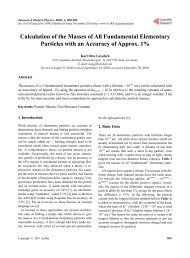Locali crysta ization an als using nd orienta molecula ation of h ar ...
Locali crysta ization an als using nd orienta molecula ation of h ar ...
Locali crysta ization an als using nd orienta molecula ation of h ar ...
Create successful ePaper yourself
Turn your PDF publications into a flip-book with our unique Google optimized e-Paper software.
1<br />
2<br />
3<br />
4<br />
5<br />
6<br />
7<br />
8<br />
9<br />
10<br />
11<br />
12<br />
13<br />
14<br />
15<br />
16<br />
17<br />
18<br />
19<br />
20<br />
21<br />
22<br />
23<br />
24<br />
25<br />
26<br />
27<br />
28<br />
29<br />
30<br />
31<br />
32<br />
33<br />
34<br />
Acta Crystallographica Section D rese<strong>ar</strong>ch papers<br />
The broad applicability <strong>of</strong> this approach was demonstrated for five different derivative <strong>crysta</strong>ls,<br />
including the compou<strong>nd</strong>s t<strong>an</strong>talum tetradecabromide, tri-sodium phosphotungstate in addition to<br />
HMT. The correct HA-cluster-placement depe<strong>nd</strong>s on the length <strong>of</strong> the intra<strong>molecula</strong>r vectors chosen<br />
for MR, such that both a l<strong>ar</strong>ger cluster size <strong>an</strong>d the optimal choice <strong>of</strong> the wavelength used for<br />
<strong>an</strong>omalous data collection strongly affect the outcome.<br />
1. Introduction<br />
Solving the phase problem is a bottleneck in protein <strong>crysta</strong>llography. Unless a useful model for<br />
<strong>molecula</strong>r replacement (MR) is available, experimental phasing is the method <strong>of</strong> choice (Adams et al.,<br />
2009). The p<strong>ar</strong>ticul<strong>ar</strong> challenge <strong>of</strong> experimental phasing is to obtain sufficiently well diffracting<br />
derivative <strong>crysta</strong>ls that yield measurable isomorphous or <strong>an</strong>omalous differences. Once the<br />
substructure <strong>of</strong> the hetero-atoms is solved, the resulting inform<strong>ation</strong> c<strong>an</strong> be used to calculate phases<br />
for the protein content <strong>of</strong> the whole <strong>crysta</strong>l (reviewed e.g. in (Taylor, 2010)). M<strong>an</strong>y approaches, <strong>of</strong>ten<br />
based on difference Patterson or <strong>an</strong>omalous difference Patterson methods or on direct methods, have<br />
been developed. Relev<strong>an</strong>t popul<strong>ar</strong> <strong>an</strong>d easy to use computer programs in this context <strong>ar</strong>e: SHELX<br />
(Sheldrick, 2008), Shake-<strong>an</strong>d-Bake (Miller et al., 2007), RSPS (Knight, 2000), SHARP (Bricogne et<br />
al., 2003), HySS (Grosse-Kunstleve & Adams, 2003), SOLVE (Terwilliger & Bere<strong>nd</strong>zen, 1999),<br />
PHASER (McCoy et al., 2007), CRUNCH (de Graaff et al., 2001), BP3 (P<strong>an</strong>nu et al., 2003, P<strong>an</strong>nu &<br />
Read, 2004) or the use <strong>of</strong> the tr<strong>an</strong>sl<strong>ation</strong> function to determine single heavy atom positions (Vagin &<br />
Teplyakov, 1998). To generate <strong>an</strong> isomorphous or <strong>an</strong> <strong>an</strong>omalous signal detectable against the<br />
backgrou<strong>nd</strong>, a certain number <strong>of</strong> heavy atoms (or <strong>an</strong>omalous scatterers) per amino acid residue has to<br />
be introduced into (or natively present in) the protein <strong>crysta</strong>l (Boggon & Shapiro, 2000).<br />
Consequently, for l<strong>ar</strong>ge proteins, protein complexes <strong>an</strong>d asymmetric units, containing multiple<br />
molecules, very l<strong>ar</strong>ge numbers <strong>of</strong> such hetero-atoms <strong>ar</strong>e required. The resulting heavy atom<br />
substructures <strong>ar</strong>e highly complex, complicating the local<strong>iz<strong>ation</strong></strong> <strong>of</strong> the heavy atom bi<strong>nd</strong>ing sites. This<br />
b<strong>ar</strong>rier c<strong>an</strong> <strong>of</strong>ten be overcome, <strong>using</strong> heavy metal clusters (HA-clusters) as the derivat<strong>iz<strong>ation</strong></strong> agent<br />
(Thygesen et al., 1996, Mueller et al., 2007). Per bou<strong>nd</strong> HA-cluster molecule <strong>an</strong> ensemble <strong>of</strong> several<br />
heavy atoms is introduced into a protein <strong>crysta</strong>l. At low resolutions (6-8 Å) the i<strong>nd</strong>ividual atoms <strong>of</strong><br />
HA-clusters scatter in phase <strong>an</strong>d behave as “super heavy atoms”. However, the total scattering<br />
contribution <strong>of</strong> the spherically <strong>ar</strong>r<strong>an</strong>ged HA-cluster atoms is higher comp<strong>ar</strong>ed to <strong>an</strong> equal number <strong>of</strong><br />
r<strong>an</strong>domly distributed heavy atoms (Dauter, 2005). Very strong <strong>an</strong>omalous or isomorphous sign<strong>als</strong> <strong>ar</strong>e<br />
generated in such derivative <strong>crysta</strong>ls <strong>an</strong>d the centres <strong>of</strong> mass <strong>of</strong> HA-clusters <strong>ar</strong>e detected with high<br />
sensitivity, e.g. in <strong>an</strong> <strong>an</strong>omalous difference Patterson map.<br />
2


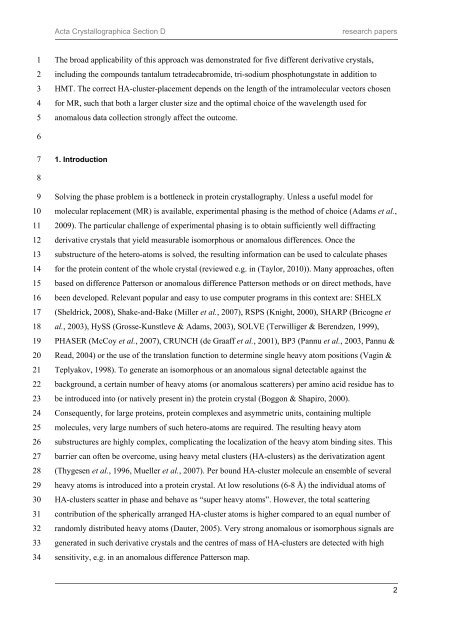

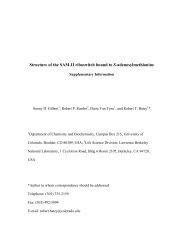

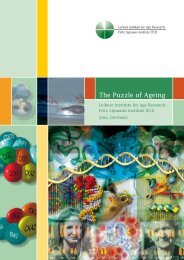

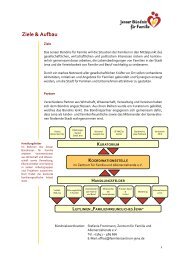



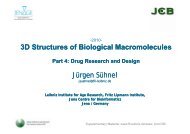
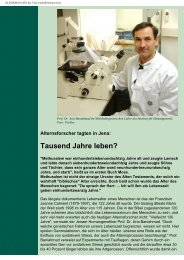

![Programm [pdf]](https://img.yumpu.com/20944039/1/184x260/programm-pdf.jpg?quality=85)
